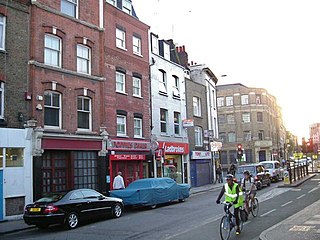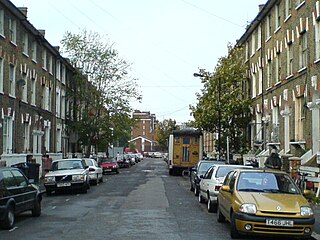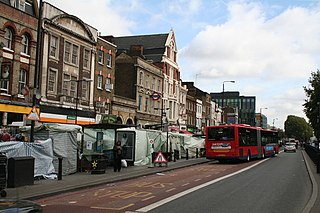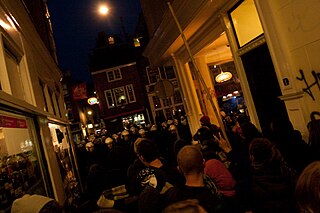Related Research Articles

Squatting is the action of occupying an abandoned or unoccupied area of land or a building, usually residential that the squatter does not own, rent or otherwise have lawful permission to use. The United Nations estimated in 2003 that there were one billion slum residents and squatters globally. Squatting occurs worldwide and tends to occur when people find empty buildings or land to occupy for housing. It has a long history, broken down by country below.

Whitechapel is an area in London, England, and is located in the London Borough of Tower Hamlets. It is in east London and part of the East End. It is the location of Tower Hamlets Town Hall and therefore the borough town centre. Whitechapel is located 3.4 miles (5.5 km) east of Charing Cross.

St Dunstan's, Stepney, is an Anglican church which stands on a site that has been used for Christian worship for over a thousand years. It is located in Stepney High Street, in Stepney, London Borough of Tower Hamlets.

Cable Street is a road in the East End of London, England, with several historic landmarks nearby. It was made famous by the Battle of Cable Street in 1936.

Villa Amalia is the name of the building that hosted the former Second High School of Athens in Greece. It is located on the corner of Acharnon and Heiden streets, near Victoria metro station. It was an anarchist squat before its eviction in 2012. It reopened as a school in 2016.

St Agnes Place was a squatted street in Kennington, south London, which resisted eviction orders for more than 30 years. When a number of derelict houses were scheduled for demolition to extend Kennington Park in 1969, squatters occupied the properties and a High Court injunction prevented the demolition. The street was run by a housing cooperative until 2005, when Lambeth London Borough Council obtained an eviction order. Demolition was completed in 2007.

London Street Commune was a hippy movement formed during the 1960s. It aimed to highlight concerns about rising levels of homelessness and to house the hundreds of hippies sleeping in parks and derelict buildings in central London.

In the history of Australia, squatting was the act of extrajudicially occupying tracts of Crown land, typically to graze livestock. Though most squatters initially held no legal rights to the land they occupied, the majority were gradually recognised by successive colonial authorities as the legitimate owners of the land due to being among the first white settlers in their area. The term squattocracy, a play on aristocracy, was coined to refer to squatters as a social class and the immense sociopolitical power they possessed.

Whitechapel Road is a major arterial road in Whitechapel, Tower Hamlets, in the East End of London. It is named after a small chapel of ease dedicated to St Mary and connects Whitechapel High Street to the west with Mile End Road to the east in Stepney. The road is part of the historic Roman road from London to Colchester, now the A11.
The Advisory Service for Squatters (A.S.S.) is a non-profit group based in London and run by volunteers. It aims to provide practical advice and legal support for squatters. It was founded in 1975, having grown out of the Family Squatters Advisory Service. After being based for many years in St. Paul's Road in Islington, A.S.S. moved its offices to Whitechapel High Street, in the same building as Freedom Press.

Arbour Square is a late Georgian square in Stepney, in the borough of Tower Hamlets, east London, England.

Norton Folgate was a liberty in Middlesex, England; adjacent to the City of London in what would become the East End of London.

The Dutch squatting ban refers to the law introduced on 1 October 2010, under which squatting in the Netherlands became de jure illegal. Criminalization had first been proposed in the 1970s, but was opposed by the Council of Churches. In 2006, a new plan was proposed and backed by parties including VVD and PVV. When the new law was introduced, squatters occupied the former head office of the fire brigade and there were riots in Amsterdam and Nijmegen. In 2011, the Supreme Court of the Netherlands ruled that the legally forced end of squatting can only occur after an intervention of a judge. Between October 2010 and December 2014, 529 people were arrested for the act of occupying derelict buildings, in 213 separate incidents as a result of which 39 people were jailed.

In England and Wales, squatting – taking possession of land or an empty house the squatter does not own – is a criminal or civil offence, depending on circumstances. People squat for a variety of reasons which include needing a home, protest, poverty, and recreation. Many squats are residential; some are also opened as social centres. Land may be occupied by New Age travellers or treesitters.

Kiefernstraße is a street in the Flingern-Süd district of Düsseldorf that became notorious in the 1980s for squatting. In the mid-1980s there were connections to the Baader–Meinhof Gang. Nowadays, the former squatters have regular leases.

121 Centre was a squatted self-managed social centre on Railton Road in Brixton, south London from 1981 until 1999. As an anarchist social centre, the venue hosted a bookshop, cafe, infoshop, library, meeting space, office space, printing facility, and rehearsal space. Organisations using the space included Food Not Bombs, Anarchist Black Cross prisoner aid chapters, an anarcho-feminist magazine, a squatters aid organisation, and an anarchist queer group. Regular events at 121 Centre included punk concerts, a women's cafe night, and a monthly queer night. The centre kept a low profile and was one of the longest-lasting squats in London.
Umbrella House is a former squat and a Housing Development Fund Corporation in New York City's East Village, at 21-23 Avenue C. The squat, formed in 1988, was known for its political engagement and high level of collective organization among its members. In 2010, the building officially became a housing cooperative.

Squatting in the Republic of Ireland is the occupation of unused land or derelict buildings without the permission of the owner. In the 1960s, the Dublin Housing Action Committee highlighted the housing crisis by squatting buildings. From the 1990s onwards there have been occasional political squats in Cork and Dublin such as Grangegorman, the Barricade Inn, the Bolt Hostel, Connolly Barracks, That Social Centre and James Connolly House.

Oval Mansions are eight separate blocks of tenement housing in Kennington, south London. The blocks stand between the Oval cricket ground and the Oval Gasholders. After being occupied by 100 squatters from 1983 until 2000, the buildings were sold off by Lambeth Council in the early 2000s.

Kasa de la Muntanya is a squatted former Guardia Civil barracks in Barcelona. It was built in 1909, by Eusebi Güell, abandoned by the police in 1983, and occupied in 1989. It became central to the squatter movement in Barcelona as a self-managed social centre. The Güell family undertook a long legal battle to regain ownership of the building and then started negotiations with the city council about its use. The council announced in 2019, a plan to buy the building and turn it into social housing.
References
- ↑ "Planning Applications for Decision and Conservation area consent" (PDF). Archived (PDF) from the original on 18 November 2021. Retrieved 18 November 2021.
- 1 2 3 SANDERSON, EILEEN (2020). LONDON POLICE STATIONS. AMBERLEY Publishing. ISBN 978-1398100169.
- ↑ Bell, Neil R. A. (2014). Capturing Jack the Ripper. Stroud, Gloucestershire [England]. ISBN 9781445621685.
{{cite book}}: CS1 maint: location missing publisher (link) - ↑ "Survey of London: Leman Street Police Station, 74 Leman Street". surveyoflondon.org.
- ↑ Morris, William (14 July 2014). The Collected Letters of William Morris, Volume II, Part B: 1885-1888. Princeton University Press. p. 456. ISBN 978-1-4008-5893-4.
- 1 2 Cobb, Neil; O'Mahony, Lorna Fox (2008). "Taxonomies of Squatting: Unlawful Occupation in a New Legal Order". The Modern Law Review. 71 (6): 878–911. doi:10.1111/j.1468-2230.2008.00721.x. JSTOR 25151250. S2CID 28777029.
- ↑ O’Neill, Sean; Nicola Woolcock (17 January 2005). "Squatters find police station is good home without any charges". Times Online. London: News International Group. Archived from the original on 13 December 2021. Retrieved 6 April 2008.
- ↑ "Squatters take over former police station". Evening Standard. 13 April 2012. Archived from the original on 18 November 2021. Retrieved 18 November 2021.